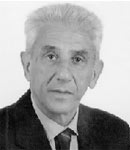DOMENICO SPINELLI
 Born in Bari (Italy) on May 30, 1932. He obtained his degree in Chemistry magna cum laude from the University of Bari in 1955. Assistant Professor of Organic Chemistry at Universities of Bari (1955-1961) and of Genoa (1962-1968), he was appointed to the Chair of Organic Chemistry at the Faculty of Pharmacy of the University of Sassari in 1968. After one year he moved to the Faculty of Sciences of the University of Palermo and finally (1974) to the Faculty of Pharmacy of the University of Bologna.
Born in Bari (Italy) on May 30, 1932. He obtained his degree in Chemistry magna cum laude from the University of Bari in 1955. Assistant Professor of Organic Chemistry at Universities of Bari (1955-1961) and of Genoa (1962-1968), he was appointed to the Chair of Organic Chemistry at the Faculty of Pharmacy of the University of Sassari in 1968. After one year he moved to the Faculty of Sciences of the University of Palermo and finally (1974) to the Faculty of Pharmacy of the University of Bologna.
For a long time Coordinator of the Ph.D. Courses in Pharmaceutical Sciences and for the Degree in Pharmacy. He has been for some decades Coordinator of several National Research Projects on ‘Synthesis and organic reactivity’ and on ‘Heterocyclic chemistry’.
Domenico Spinelli has served the chemical community for several and several years. Member of Executive Committee (1987-1992) and then President (1993-1995) of the Division of Organic Chemistry of the Italian Chemical Society; Vice-President (1996-1998), President (1999-2001), and past-President (2002-2004) of the Italian Chemical Society. He has been member of the European Committee for European Journals.
In 1974 he received the golden ‘Sigillum Magnum’ of the University of Palermo, and in the years he was awarded the ‘A. Mangini’ and the ‘D. Marotta’ golden medals as well as the golden ‘Sigillum’ of the Italian Chemical Society. Honorary life member of ISBC (India). Member of the European Academy of Sciences and Arts.
He is author of over three hundred papers (in J. Chem. Soc. Perkin Trans. 1 and 2, Chem. Commun., Tetrahedron and Tetrahedron Lett., J. Org. Chem., J. Phys. Chem. A, J. Am. Chem. Soc., J. Med. Chem., etc.) dealing with the study of the reactivity and properties of several five-membered heterocycles [thiophenes and benzothiophenes (nucleophilic aromatic substitutions); 1,2,4-oxadiazoles and isoxazoles (mononuclear rearrangements of heterocycles); imidazoles and condensed imidazoles (ring-opening-ring closing reactions); 1,3,4-oxadiazoles, 1,3,4-thiadiazoles and thiazoles (decarboxylation reactions); furans and congeners (enolisation processes); etc.]; of the micellar catalysis; of the mutagenic and antitumour properties of nitro compounds; of the pharmacological properties (LTCC blockers and agonist of MDR activity) of thiazinooxadiazolones; etc.
